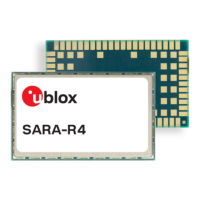SARA-R42 - Application note
UBX-20050829 - R02 Application design and development Page 11 of 58
C1-Public
3.2.5 Core application
For some details and guidelines on this topic, see the Internet applications development guide
application note [5] and SARA-R4 series AT command manual [2]. The application shall handle AT
commands, responses and unsolicited indications as suggested in section 4. For diagnostic purposes,
the application should rely on status AT commands, see section 9.1. For robustness purposes, the
application should implement embedded watchdog procedures, see section 9.2.
3.2.6 Power-off
The application might need to switch off the module; both normal and emergency shutdown are
described in the SARA-R4 series system integration manual [3].
3.3 Application modes
An application is usually designed based on the main use cases in actual scenarios. This way of
operation is what we call “normal mode”. In addition, the designer should provide a way to configure
the application for more specific contexts, which can have different requirements with respect to
normal mode and can help to perform other important steps in the product lifecycle.
3.3.1 Debug / test mode
In general, an application should always output a significant log, including the AT commands it issues
and their responses, and implement monitoring strategies as described in section 9.
If a problem occurs related to the cellular module and more information is needed, it may be necessary
to configure different verbosity levels for the host application and modules log. This can be done with
configuration files, that can be side-loaded to the file system. In extreme cases, it may be necessary
to provide an AT interface passthrough to allow access to diagnostic AT commands.
If the cellular communication is tested against a network simulator, use a suitable test SIM card
(usually provided by the network simulator manufacturer). If a test SIM card is not available, make
sure to disable authentication and integrity checks on the tester side (by proper setting) and on the
module (by using the AT+UDCONF=81,0 command, see SARA-R4 series AT commands manual [2]).
3.3.2 Production testing
This mode is to be used during the production tests of the end device. In this scenario the main
application is usually inactive, and AT commands can be used to properly configure the module and
use its end user testing features (see section 10).
3.3.3 Certification mode
Depending on the kind of certification, such as regulatory, conformance or for MNO type approval, the
application might be disabled, and the module externally controlled (for example, for throughput
testing). Specific MNO tests might require the application to be running in normal mode (for example,
remote SIM provisioning, FOTA).
3.3.4 Firmware update mode
A module’s firmware update should be implemented when necessary, either over the air or tethered.
Each update strategy has its requirements and correct implementation, which should be followed to
guarantee the success of the operation. See the SARA-R4 FW update application note [4] for more
details.

